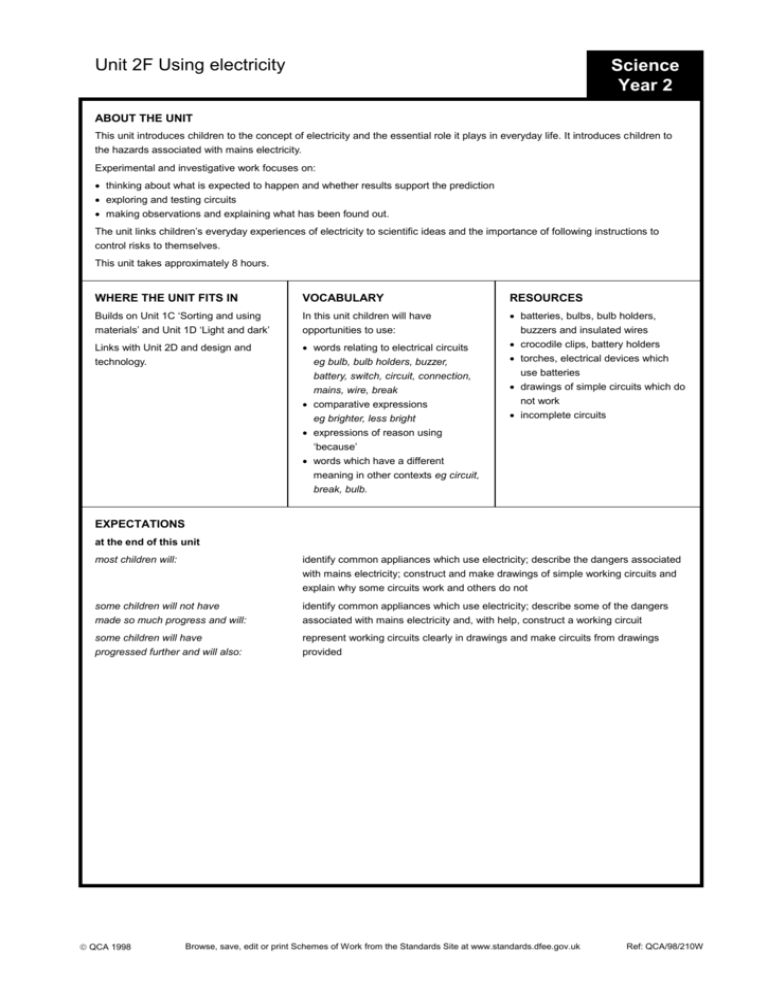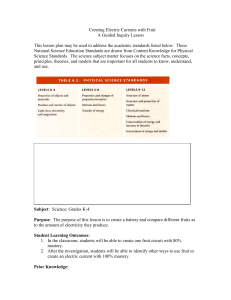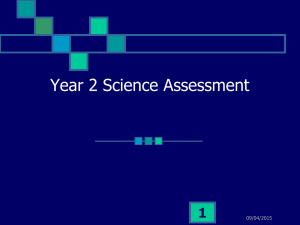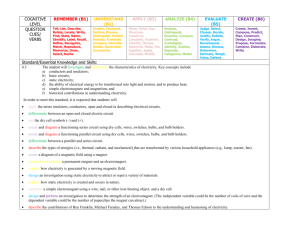Unit 2F Using electricity - Constantine Primary School
advertisement

Unit 2F Using electricity Science Year 2 ABOUT THE UNIT This unit introduces children to the concept of electricity and the essential role it plays in everyday life. It introduces children to the hazards associated with mains electricity. Experimental and investigative work focuses on: thinking about what is expected to happen and whether results support the prediction exploring and testing circuits making observations and explaining what has been found out. The unit links children’s everyday experiences of electricity to scientific ideas and the importance of following instructions to control risks to themselves. This unit takes approximately 8 hours. WHERE THE UNIT FITS IN VOCABULARY RESOURCES Builds on Unit 1C ‘Sorting and using materials’ and Unit 1D ‘Light and dark’ In this unit children will have opportunities to use: Links with Unit 2D and design and technology. words relating to electrical circuits eg bulb, bulb holders, buzzer, battery, switch, circuit, connection, mains, wire, break comparative expressions eg brighter, less bright expressions of reason using ‘because’ words which have a different meaning in other contexts eg circuit, break, bulb. batteries, bulbs, bulb holders, buzzers and insulated wires crocodile clips, battery holders torches, electrical devices which use batteries drawings of simple circuits which do not work incomplete circuits EXPECTATIONS at the end of this unit most children will: identify common appliances which use electricity; describe the dangers associated with mains electricity; construct and make drawings of simple working circuits and explain why some circuits work and others do not some children will not have made so much progress and will: identify common appliances which use electricity; describe some of the dangers associated with mains electricity and, with help, construct a working circuit some children will have progressed further and will also: represent working circuits clearly in drawings and make circuits from drawings provided QCA 1998 Browse, save, edit or print Schemes of Work from the Standards Site at www.standards.dfee.gov.uk Ref: QCA/98/210W Browse, save, edit or print Schemes of Work from the Standards Site at www.standards.dfee.gov.uk LEARNING OBJECTIVES Primary Schemes of Work: Science Unit 2F Using electricity POSSIBLE TEACHING ACTIVITIES LEARNING OUTCOMES CHILDREN SHOULD LEARN POINTS TO NOTE CHILDREN that everyday appliances use electricity; these include things that light up, heat up, produce sounds and move Explore the classroom and identify appliances which use mains electricity and those which do not. Talk about electricity and its potential dangers with children. Visit other parts of the school, identifying other electrical appliances, plug sockets and lights. Help children to make a record of all the appliances identified, together with their use. Group the appliances into categories depending on what they do. Talk with children about those that are difficult to group. identify appliances which use electricity eg lamp, tape recorder, television and those which do not eg pencil-sharpener, stapler record the appliances in categories and justify the groupings eg say that the tape recorder and the radio both make sounds The scientifically correct term for a single ‘battery’ is a cell. Teachers will need to decide whether it is appropriate to introduce this to children at this stage. that everyday appliances are connected to the mains and that they must be used safely Show a video or video clip about electrical safety and talk with children about dangerous and less dangerous sources of electricity. Show children a collection of batteries and discuss batteries as a safe source of electricity. tell someone eg visitor, parent, other child that mains sockets are dangerous eg the electricity is so powerful it could kill you and that plugs should not be touched with wet hands SAFETY – Mains appliances, including those brought in from home, should only be used if they have been subject to an electrical supply check. QCA 1998 1 Ref: QCA/98/210W Browse, save, edit or print Schemes of Work from the Standards Site at www.standards.dfee.gov.uk LEARNING OBJECTIVES Primary Schemes of Work: Science Unit 2F Using electricity POSSIBLE TEACHING ACTIVITIES LEARNING OUTCOMES CHILDREN SHOULD LEARN POINTS TO NOTE CHILDREN that some devices use batteries which supply electricity; these can be handled safely to make connections in circuits to the positive and negative poles of the battery Present children with a collection of devices which use batteries and appropriate batteries for them. Ask children to identify which battery would be used for each device bearing in mind that button batteries should not be used by young children. Help children to examine a battery and identify the symbols + and – . Demonstrate a device where it is important that the battery is in the correct orientation eg a remote control for the video recorder. Ask children to dismantle and reassemble torches so that they light up again. use devices with batteries, draw and label some of these eg bicycle lamps, hearing aids explain why a particular device requires a particular battery eg a watch is very small so it needs a small battery identify ways batteries might be dangerous eg a small child might swallow one, if the battery were cut open the chemicals could escape and cause harm SAFETY – Never cut open batteries. Rechargeable batteries are best avoided (except enclosed in devices such as roamers) as they can get extremely hot if short-circuited. ‘Button’ batteries could be demonstrated but are not suitable for use by small children. Car batteries are unsuitable for use in primary schools. to make a complete circuit using a battery, wires and bulbs explore how to make a bulb light, explaining what happened, and using drawings to present results Present children with a collection of batteries, insulated wires and matched bulbs or buzzers. Challenge them to make the bulb light or buzzer sound. Ask children to draw pictures to show their working circuits and to explain their drawings indicating why the circuits work. make working circuits using bulbs and/or buzzers and make drawings of these Children will find it easier to understand the concept of a circuit if they have many opportunities to construct circuits. On some occasions they should not use a bulb holder, because this helps them to see where the connections are. QCA 1998 When children draw circuits at this stage they will not use standard symbols. However, they may design their own. 2 Ref: QCA/98/210W Browse, save, edit or print Schemes of Work from the Standards Site at www.standards.dfee.gov.uk LEARNING OBJECTIVES Primary Schemes of Work: Science Unit 2F Using electricity POSSIBLE TEACHING ACTIVITIES LEARNING OUTCOMES CHILDREN SHOULD LEARN POINTS TO NOTE CHILDREN that an electrical device will not work if there is no battery or if there is a break in the circuit to make and test predictions about circuits that will work to make and record observations in drawings to say whether the evidence supports the predictions to explain what happened, drawing on their knowledge of circuits Give children examples of circuits that do not work and ask them to make them work and describe and explain how they did this. In addition, give children drawings of circuits and ask them to predict whether they will work eg by making a bulb light up. Ask children to construct the circuits to test their predictions, make a record of their results and explain what happened. recognise simple drawings of circuits which will not work eg with connections to only one terminal of battery or a circuit with a break and explain why the bulb will not light interpret drawings of circuits making correct predictions of which circuits will work and explaining these eg saying this won’t work because both wires are attached to the same end of the battery Some children may be ready to use more than one bulb and may use a switch. that these circuits can be used to make simple devices Present children with materials to make a circuit and buzzers and bulbs. Ask children to suggest a problem that needs to be solved eg make a warning device, a toy lighthouse, a house with a light in it, a choice card. Children identify solutions and decide which to make. design, make, test and demonstrate their device and explain the importance of a complete circuit in it A context for this activity could be introduced through a story or topical event or in relation to another area of the curriculum. QCA 1998 3 Ref: QCA/98/210W






